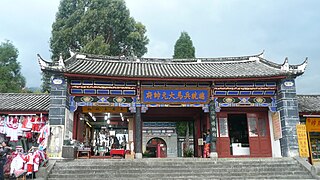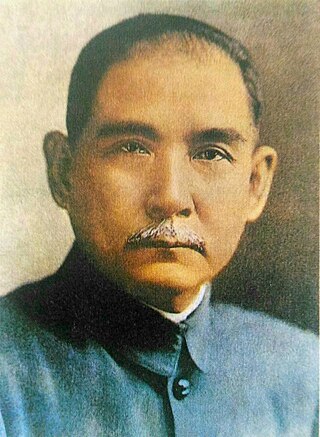
Dalai Lama is a title given by the Tibetan people to the foremost spiritual leader of the Gelug or "Yellow Hat" school of Tibetan Buddhism, the newest and most dominant of the four major schools of Tibetan Buddhism. The 14th and current Dalai Lama is Tenzin Gyatso, who lives in exile as a refugee in India. The Dalai Lama is also considered to be the successor in a line of tulkus who are believed to be incarnations of Avalokiteśvara, the Bodhisattva of Compassion.

Sino-Tibetan, also cited as Trans-Himalayan in a few sources, is a family of more than 400 languages, second only to Indo-European in number of native speakers. The vast majority of these are the 1.3 billion native speakers of Sinitic languages. Other Sino-Tibetan languages with large numbers of speakers include Burmese and the Tibetic languages. Other languages of the family are spoken in the Himalayas, the Southeast Asian Massif, and the eastern edge of the Tibetan Plateau. Most of these have small speech communities in remote mountain areas, and as such are poorly documented.

Tibet is a region in Asia, covering much of the Tibetan Plateau and spanning about 2,500,000 km2 (970,000 sq mi). It is the homeland of the Tibetan people. Also resident on the plateau are some other ethnic groups such as the Monpa, Tamang, Qiang, Sherpa and Lhoba peoples and, since the 20th century, considerable numbers of Han Chinese and Hui settlers. Since the 1951 annexation of Tibet by the People's Republic of China, the entire plateau has been under the administration of the People's Republic of China. Tibet is divided administratively into the Tibet Autonomous Region, and parts of the Qinghai and Sichuan provinces. Tibet is also constitutionally claimed by the Republic of China (Taiwan) as the Tibet Area since 1912.

The Tibet Autonomous Region or Xizang Autonomous Region, often shortened to Tibet or Xizang, is a province-level autonomous region of the People's Republic of China in Southwest China. It was overlayed on the traditional Tibetan regions of Ü-Tsang and Kham.

Min is a broad group of Sinitic languages with about 70 million native speakers. These languages are spoken in Fujian province as well as by the descendants of Min-speaking colonists on the Leizhou Peninsula and Hainan, or by the assimilated natives of Chaoshan, parts of Zhongshan, three counties in southern Wenzhou, the Zhoushan archipelago, Taiwan, and Singapore. The name is derived from the Min River in Fujian, which is also the abbreviated name of Fujian Province. Min varieties are not mutually intelligible with one another nor with any other variety of Chinese.
The Tibetan people are an East Asian ethnic group native to Tibet. Their current population is estimated to be around 6.7 million. In addition to the majority living in Tibet Autonomous Region of China, significant numbers of Tibetans live in the Chinese provinces of Gansu, Qinghai, Sichuan, and Yunnan, as well as in India, Nepal, and Bhutan.

Du Wenxiu was the Chinese Muslim leader of the Panthay Rebellion, an anti-Qing revolt in China during the Qing dynasty. Du had ethnic Hui ancestry.

Yusuf Ma Dexin was a Hui Chinese Hanafi-Maturidi scholar from Yunnan, known for his fluency and proficiency in both Arabic and Persian, and for his knowledge of Islam. He also went by the Chinese name Ma Fuchu. He used the Arabic name Abd al-Qayyum Ruh al-Din Yusuf. He was also styled as "Mawlana al-Hajj Yusuf Ruh al-Din Ma Fujuh".

Lhasa Tibetan, or Standard Tibetan, is the Tibetan dialect spoken by educated people of Lhasa, the capital of the Tibetan Autonomous Region of China. It is an official language of the Tibet Autonomous Region.

The 1959 Tibetan uprising began on 10 March 1959, when a revolt erupted in Lhasa, the capital of Tibet, which had been under the effective control of the People's Republic of China (PRC) since the Seventeen Point Agreement was reached in 1951. The initial uprising occurred amid general Chinese-Tibetan tensions and a context of confusion, because Tibetan protesters feared that the Chinese government might arrest the 14th Dalai Lama. The protests were also fueled by anti-Chinese sentiment and separatism. At first, the uprising mostly consisted of peaceful protests, but clashes quickly erupted and the Chinese People's Liberation Army (PLA) eventually used force to quell the protests, some of the protesters had captured arms. The last stages of the uprising included heavy fighting, with high civilian and military losses. The 14th Dalai Lama escaped from Lhasa, while the city was fully retaken by Chinese security forces on 23 March 1959. Thousands of Tibetans were killed during the 1959 uprising, but the exact number of deaths is disputed.

The 14th Dalai Lama, and known to the Tibetan people as Gyalwa Rinpoche, is the current Dalai Lama, also the highest spiritual leader and head of Tibet. He is considered a living Bodhisattva; specifically, an emanation of Avalokiteśvara in Sanskrit and Chenrezig in Tibetan. He is also the leader and a monk of the Gelug school, the newest school of Tibetan Buddhism, formally headed by the Ganden Tripa. The central government of Tibet, the Ganden Phodrang, invested the Dalai Lama with temporal duties until his exile in 1959.

Anti-Qing sentiment refers to a sentiment principally held in China against the rule of the Manchu-led Qing dynasty (1636–1912), which was criticized by opponents as being "barbaric". The Qing was accused of destroying traditional Han culture by enforcing policies such as forcing Han to wear their hair in a queue in the Manchu style. It was blamed for suppressing Chinese science, causing China to be transformed from the world's premiere power to a poor, backwards nation. The people of the Eight Banners lived off government pensions unlike the general Han civilian population.

The Tibetan Empire was an empire centered on the Tibetan Plateau, formed as a result of imperial expansion under the Yarlung dynasty heralded by its 33rd king, Songtsen Gampo, in the 7th century. The empire further expanded under the 38th king, Trisong Detsen. The 821–823 treaty concluded between the Tibetan Empire and the Tang dynasty delineated the former as being in possession of an area larger than the Tibetan Plateau, stretching east to Chang'an, west beyond modern Afghanistan, and south into modern India and the Bay of Bengal.

Xinlong County is a county in the west of Sichuan Province, China. It is under the administration of the Garzê Tibetan Autonomous Prefecture.
Ma Rulong was a Chinese Muslim who originally rebelled against the Qing dynasty along with Du Wenxiu in the Panthay Rebellion. He later defected to the Qing side. After officially surrendering in 1862 his forces effectively occupied the capital of Yunnan. He then helped the Qing forces crush his fellow Muslim rebels, and defeated them. He was known by the name of Marshal Ma to Europeans and achieved almost total control in Yunnan province. He was the most powerful military official in the province after the war.
Ma Shenglin was a Hui Jahriyya Sufi rebel who fought against the Qing dynasty in the Panthay Rebellion.
The Chadong language is a Kam–Sui language spoken mainly in Chadong Township, Lingui County, Guilin, northeastern Guangxi, China. It is most closely related to the Maonan language. Chadong has only been recently described by Chinese linguist Jinfang Li in the 1990s and 2000s.
The Panthay Rebellion (1856–1873), also known as the Du Wenxiu Rebellion, was a rebellion of the Muslim Hui people and other ethnic groups against the Manchu-led Qing dynasty in southwestern Yunnan Province, as part of a wave of Hui-led multi-ethnic unrest.
Events from the year 1862 in China.
The Nanping dialect, or Nanping Mandarin, is a dialect of Mandarin Chinese spoken in Yanping District, in Nanping, Fujian. Locally, it is known as Tuguanhua. It is one of three Mandarin dialect islands in Fujian.














